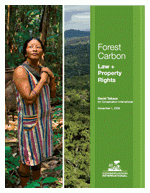Forest Carbon
Law + Property Rights
By David Takacs - Conservation International View PublicationInvestments in reforestation and reducing emissions from deforestation and degradation (REDD) have the potential to mitigate greenhouse gas accumulation; sustain ecosystem services that support human and ecological communities; and generate sustainable livelihoods for poor, forest-dependent people. But as a new form of property, forest carbon presents legal complications that no jurisdiction has completely untangled.
This guide is designed to help community members, government leaders, lawyers, treaty negotiators, NGO advocates, and carbon investors understand forest carbon as property in order to support and develop sustainable forest carbon projects. In this report, sustainable projects are defined as being: 1) effective, i.e. they work without complication and deliver and maintain the desired carbon benefits over the long term; 2) synergistic, i.e. they maximize benefits for local communities, biodiversity, climate, and investors; and 3) equitable, i.e. benefits are fairly and equitably shared among the various parties (stakeholders) with special attention paid to the poor and marginalized. The report stresses that equitable forest carbon investments are not only ethically preferable but will also result in projects that are more sustainable and financially prudent.

